Apart from being one of the most snake-populated states in the United States, Florida is also known to have some of the largest snake species. According to the Florida Fish and Wildlife Conservation Commission, the state houses 44 native snake species, and many of these species are found near Tampa and the Florida Gulf Coast.
If you’ve ever wondered which of Florida’s snakes are the biggest, either by weight or length, you’re in for a treat. Discover the largest snakes near Tampa and the Florida Gulf Coast. This article covers all the details.
Burmese Python (Python bivittatus)
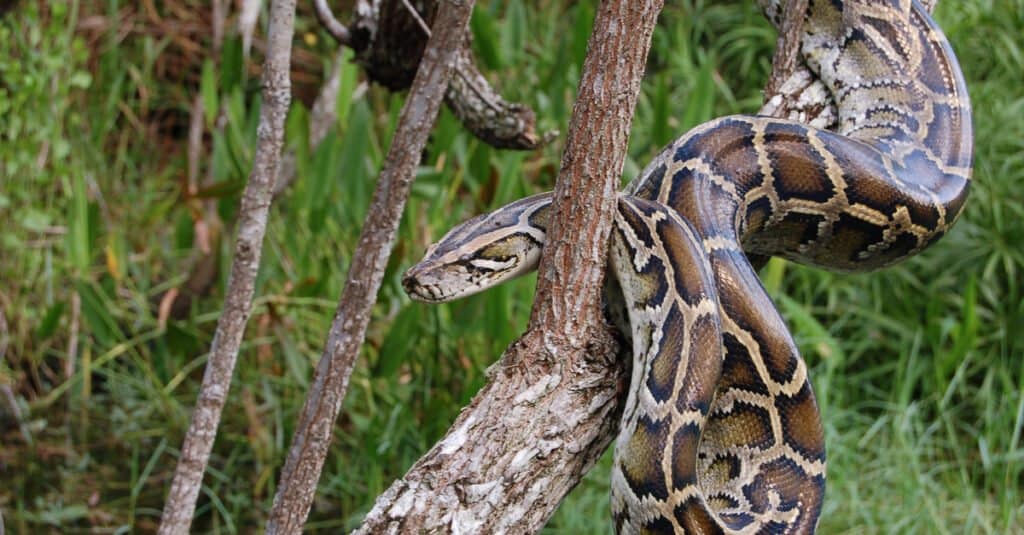
Burmese pythons are the largest species of snakes found in Florida.
©Heiko Kiera/Shutterstock.com
The largest species of snake found in Florida is the Burmese python. However, these pythons aren’t native species — they invaded Florida many years ago. When species invade a location, it becomes easier for them to thrive because the area may lack natural predators that can eat or compete with it for food.
Consequently, they grow larger than they normally would in their native or natural habitats. This is one reason that Florida has a large number of large Burmese pythons. Other animals also fear Burmese pythons as they are among the deadliest predators and are known to attack animals much larger than them.
Naturally, Burmese pythons are large. As babies, they are as long as 2 feet and grow up to 16 feet in length. In Florida, species as large as 18 feet and as heavy as 300 pounds have been recorded!
Eastern Diamondback Rattlesnake (Crotalus adamanteus)
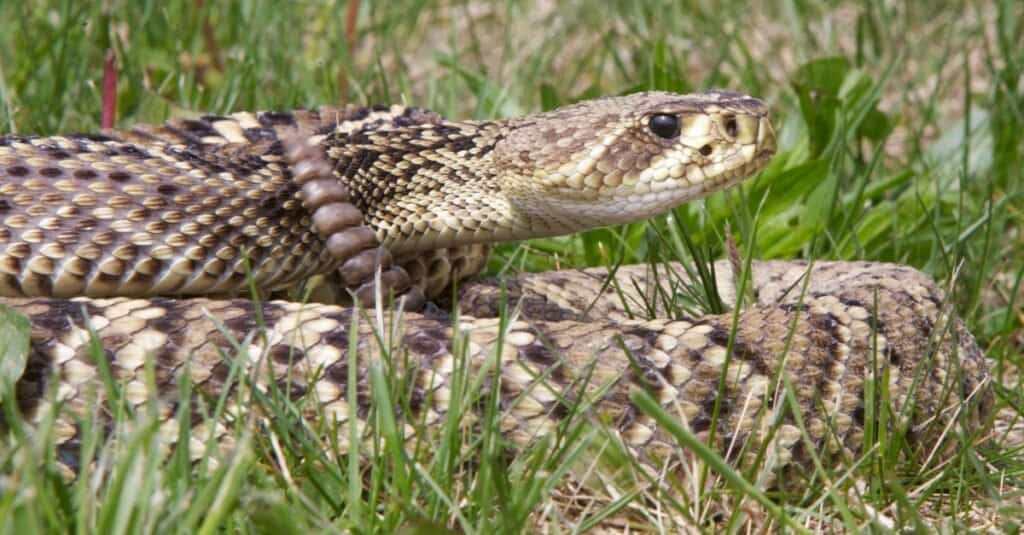
The eastern diamondback rattlesnake was a symbol on one of the first flags of the United States.
©iStock.com/NajaShots
Eastern diamondback rattlesnakes are venomous rattlesnakes found all over North America and can be spotted near Tampa and the Florida Gulf Coast. These snakes weigh 4 to 5 feet on average but have been known to grow up to 7.8 feet.
In addition to their size, eastern diamondback rattlesnakes are one of the most venomous snakes on the continent. They are quick to bite and have primarily hemotoxic venom that attacks blood cells. Hemotoxins also lead to circulatory and respiratory problems, and cause swelling, necrosis, and damage tissues in the bitten area. Victims often report bleeding from the mouth, swelling, hypotension, and intense pain. Untreated eastern diamondback rattlesnakes’ bites have a fatality rate of 10-20%.
They are colored blackish-gray, olive green, and muddy gray, making it easy for them to hide or camouflage in the wild. They have keeled scales with irregular botches close to their heads. Eastern diamondback rattlesnakes are pit vipers, which hints at their pit organs that give them infrared vision.
Boa Constrictor (Boa constrictor)

Boa constrictors are found in tropical Southern America and some islands in the Caribbean.
©Jan Hejda/Shutterstock.com
Boa constrictors are also known as red-tailed boas or common boas and are found in tropical Southern America and some islands in the Caribbean. These snakes are large and heavy-bodied, making them deadly constrictors. Luckily, they do not produce venom as they are members of the Boidae snake family.
On average, boa constrictors measure 6-10 feet but can measure up to 12 feet long. These snakes are equally heavy and weigh 22 to 33 pounds on average, with some species attaining 100 pounds. It is important to note that this species is highly variable in size and weight depending on its locality and the presence of prey and predators.
Central African Rock Python (Python sebae)
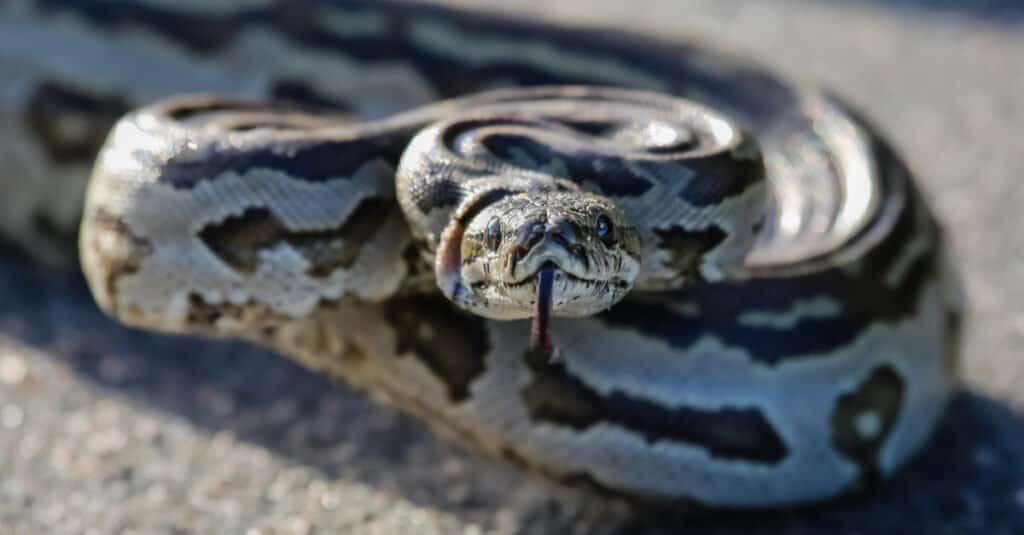
The largest snake species in Africa is the Central African rock python.
©Uwe Bergwitz/Shutterstock.com
The Central African rock python is the largest species of snake in Africa as well as one of the six largest snake species in the world. Also known as the rock python, this constrictor measures 9 feet 10 inches to 11 feet 7 inches (3 to 3.53 meters) with a maximum of 20 feet.
As you might decipher from its name, the Central African rock python isn’t native to Florida. However, just like the Burmese python, the rock python, first spotted on Florida’s grounds in 2009, is an invasive species. Due to its size, the Central African rock python has claimed human lives through constriction.
Eastern Indigo Snake (Drymarchon couperi)
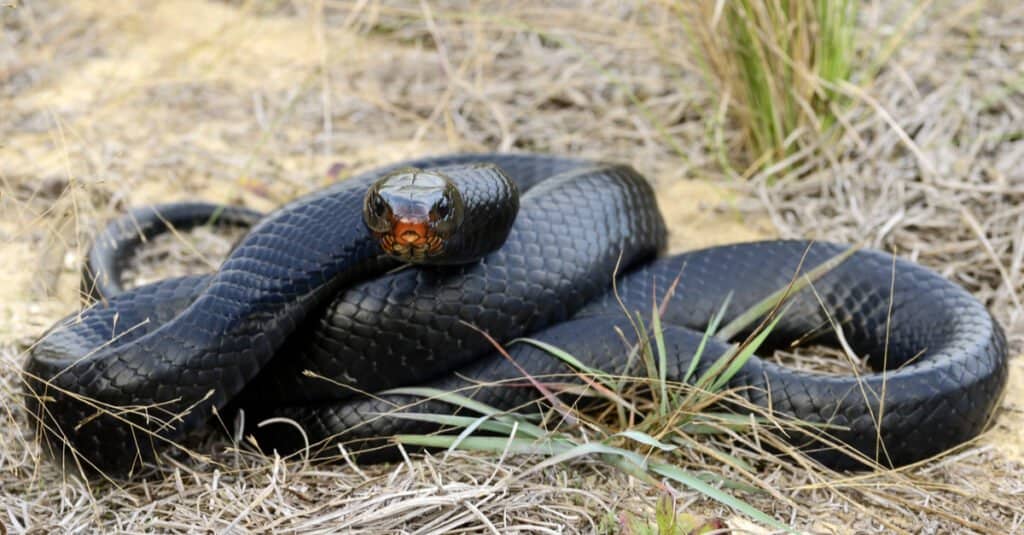
Eastern indigo snakes are nonvenomous colubrid snakes.
©Patrick K. Campbell/Shutterstock.com
Eastern indigo snakes are nonvenomous colubrid snakes known for their docile natures. They are also North America’s largest native species. On average, eastern indigo snakes measure 3.6–7.7 feet (1.2–2.36 m) and anywhere from 1.6 to 9.9 pounds (0.72–4.5 kg).
These snakes are named after their beautifully colored dorsal and ventral scales. They take on a glossy blackish-purple shade in bright light. Eastern indigo snakes are often kept as pets but are listed as federally threatened in Florida, mostly due to humans. Habitat loss and fragmentation are two major reasons they have been virtually erased in the northern parts of Florida.
Florida Pine Snake (Pituophis melanoleucus mugitus)
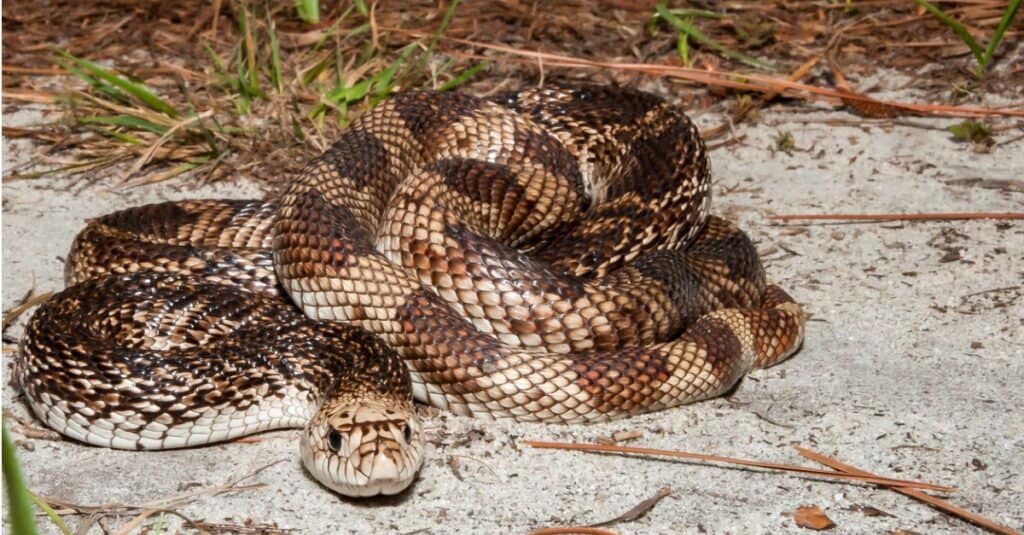
Though non-venomous, the Florida Pine snake squeezes its prey to death.
©iStock.com/JasonOndreicka
Florida pine snakes are nonvenomous colubrids that grow 48–90 inches on average and are native to the southeastern United States. Although they vary slightly in color, they are usually gray with dark brown blotches that run down their backs, but not their bellies which are plain white.
Despite their lack of venom, these snakes are known to bite — and powerfully too. However, they hardly bite and often bluff-bite and hiss out loud to scare off their prey. Most recorded bites from these animals were in a bid to protect themselves, which they do not hesitate to do. Luckily, their bites aren’t life-threatening due to their lack of venom.
Eastern Rat Snake (Pantherophis alleghaniensis)

Eastern rat snakes are smart snakes known to mimic venomous snakes to scare away predators.
©Mike Wilhelm/Shutterstock.com
Generally, rat snakes are one of the longest snake species, and eastern rat snakes, a subspecies, are no exception. Eastern rat snakes measure from 36 to 72 inches with a maximum length of 90 inches. They have shiny black scales over their upsides and cream or white bellies, and their throats and chins are also white.
Eastern rat snakes are smart snakes known to mimic venomous snakes to scare away predators. One way they do this is by fiercely vibrating or flicking their tails to mimic rattlesnakes. They are also known to inflate their head to give it a large and triangular shape, just like venomous snakes.
The Most Common Snakes in Florida
These 7 large snakes are among 50 species in Florida. Other, smaller snakes that can be commonly seen in the state are:
- Eastern kingsnakes: These nonvenomous constrictors can be found across much of the Sunshine State but are absent from the eastern Apalachicola lowlands.
- Eastern coachwhips: Common throughout the mainland (but not Florida Keys), these snakes are not aggressive and normally flee when disturbed.
- Ring-necked snakes: One of the most abundant but secretive species, there are two subspecies that live in the state — key ring-necked snakes and southern ring-necked snakes.
- Southern black racers: Among the most widespread snakes, present in Florida and the Florida Keys, these fast and agile racers are often seen in residential areas.
- Florida green water snakes: These are the longest water snakes in North America and can grow 30-55 inches long. They are found across much of mainland Florida but not the Florida Keys.
For more common snakes in Florida go here.
What To Do If You Come Across A Snake Near Tampa and the Florida Gulf Coast
Most snake bites occur due to humans not respecting snakes’ boundaries as few snakes are aggressive or known to bite without being incited. So, if you come across a snake, respect its boundaries and leave it alone. If you’ve been bitten by a snake, venomous or not, sit still to avoid circulation and contact emergency services immediately.
Animals That Live in Florida
In addition to snakes, the state of Florida is home to many different nonvenomous and venomous animal species living in its 5 ecosystems. While some of these can also post a threat to people when threatened, including alligators, sharks, black bears, bobcats, and black widow spiders, other animals are the ones at threat.
One of the most notable animals in Florida is the Florida Panther, the state’s official animal. They are endangered, with fewer than 150 of them left in the state, and it has been illegal to hunt them since 1958. Unlike panthers in other parts of the world, this native species is not black but tan and brown, appearing more like a big bobcat.
Another native species under threat is the manatee, which was designated as the state marine mammal in 1975. Manatees can be found in the rivers and bays of Florida, particularly during winter when they are in search of warmer water.
The alligator, adopted as the state reptile in 1987, was once endangered, but its populations have recovered after a period of over-hunting and there are now around 1.3 million alligators in Florida lakes. For more information on animals in Florida visit here.
The photo featured at the top of this post is © iStock.com/sstaton
Discover the "Monster" Snake 5X Bigger than an Anaconda
Every day A-Z Animals sends out some of the most incredible facts in the world from our free newsletter. Want to discover the 10 most beautiful snakes in the world, a "snake island" where you're never more than 3 feet from danger, or a "monster" snake 5X larger than an anaconda? Then sign up right now and you'll start receiving our daily newsletter absolutely free.
Thank you for reading! Have some feedback for us? Contact the AZ Animals editorial team.






